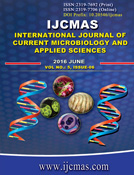


 National Academy of Agricultural Sciences (NAAS)
National Academy of Agricultural Sciences (NAAS)

|
PRINT ISSN : 2319-7692
Online ISSN : 2319-7706 Issues : 12 per year Publisher : Excellent Publishers Email : editorijcmas@gmail.com / submit@ijcmas.com Editor-in-chief: Dr.M.Prakash Index Copernicus ICV 2018: 95.39 NAAS RATING 2020: 5.38 |
The incidence of serious fungal infections continues to rise. Amongst them infections due to candida species are increasing in the last few decades due to increase in HIV infection, immune compromised conditions like use of steroids, broad spectrum antibiotics, drug abuse, organ transplantation& so on. The distribution of Candida species causing infections is changing. Till recent past, C. albicans was the most common species causing infections but more recently the infections caused due to non albicans candida (NAC) species are on rise. The present study was planned for studying the various clinical isolates of candida, its predisposing factors, the use of CHROM agar for rapid identification and its antifungal susceptibility pattern. A total of 100 clinical isolates of candida reported as pathogenic were studied for identification by conventional method and by growth on CHROM agar and corn meal agar. It’s antifungal susceptibility testing was done on Muller Hinton with glucose and methylene blue agar by disc diffusion method. The clinical history of the patients was elicitated for risk factors. Out of 100 candida isolates, 41 strains were C. albicans and 59 were NAC belonging to different species, commonest being C. tropicalis. Maximum isolates were obtained from urine sample and Diabetes mellitus was found to be the commonest risk factor associated (34%) followed by pregnancy (16%). The C. albicans showed highest sensitivity to Amphotericin B followed by Fluconazole. NAC showed maximum sensitivity to Voriconazole followed by Fluconazole and Amphotericin B. Rapid identification of different candida species is possible by growth on CHROM agar by differences in the color of the colonies and the study of morphology on corn meal agar. It is important to do species identification and antifungal susceptibility, as susceptibility varies according to the type of infecting candida species and hence use of CHROM agar with disc diffusion susceptibility testing on methylene blue glucose Muller Hinton agar is a simple, cost effective method. It can be used in resource restricted settings without requirement of any costly instrument.
 |
 |
 |
 |
 |